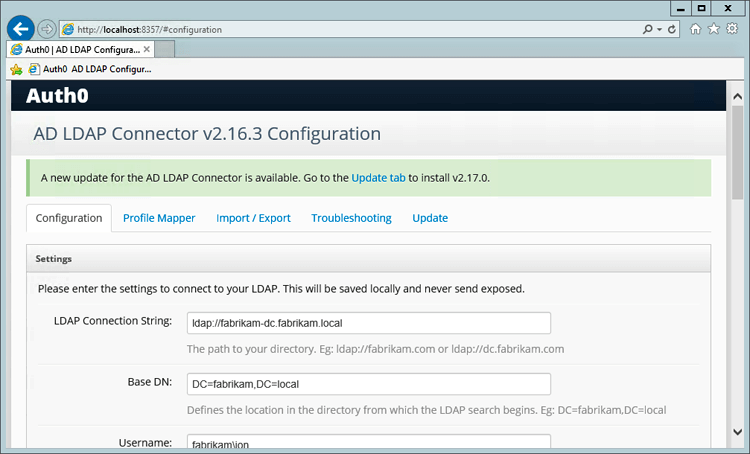Update AD/LDAP Connectors
If there are multiple instances of the AD/LDAP Connector in your deployment, Auth0 recommends that you perform the steps below for each instance one at a time, so that only one instance is down at any point.
Admin console (Windows)
Open the Admin Console by navigating to http://localhost:8357/. If the Admin Console has outbound access to the internet it will verify if a new version is available and show this on top of the page:

Go to the Update tab to update the installation on the current machine to the latest version. The update will take about 2 minutes and the updater logs will be displayed in the Admin Console.
Updater script (Windows)
The updater script will update the AD/LDAP Connector from the command line by running the following steps:
Verify if an update is available.
Backup the existing configuration, certificates and profileMapper.js.
Uninstall the AD/LDAP Connector.
Download the update.
Install the AD/LDAP Connector.
Restore the existing configuration, certificates and profileMapper.js.
Start the Windows Service.
To run the updater script execute the following statement in the command line:
@powershell -NoProfile -ExecutionPolicy Bypass -Command "iex ((new-object net.webclient).DownloadString('https://cdn.auth0.com/connector/windows/update-connector.ps1'))"
The updater script uses specific PowerShell commands that are only available in Windows PowerShell 3.0 and higher. If you're running on Windows 2008 and Windows 2008 R2 you might need to update your PowerShell version first.
To learn more, see Download Window Management Framework.
Manual update (Windows/Linux)
Verify the version you have installed. Hover over the Connector status indicator on the console. The tooltip will indicate the current status and the installed version.
Download the latest version of the installer. Use the GitHub repository version for other platforms.
Backup your current configuration from the Admin Console or manually.
From the Admin Console, click the Download button to generate a .zip file which contains the
config.jsonfile, thecertsfolder and thelib\\profileMapper.jsfile.To do it manually, backup the same files listed above from
%Program Files(x86)%\Auth0\AD LDAP Connector\folder. The path works for Windows. Files in other platforms may be located somewhere else but will contain the same assets.
Run the installer and follow the instructions.
Close the Configuration dialog without changing anything.
Restore files from the Admin Console or manually.
From the Admin Console, upload the .zip file on the Import / Export tab.
To do it manually, copy the files you backed up previously.
Restart the Auth0 AD LDAP service from the service console.
